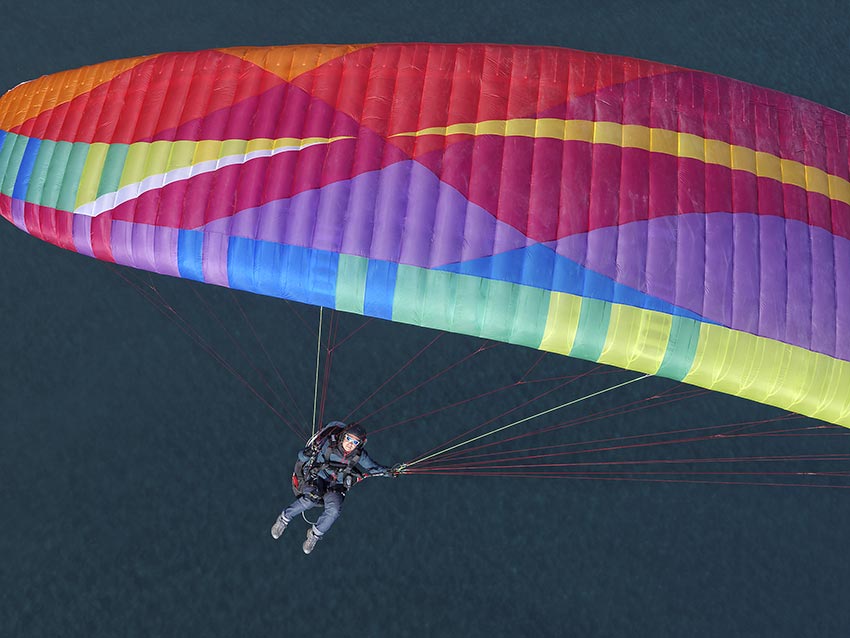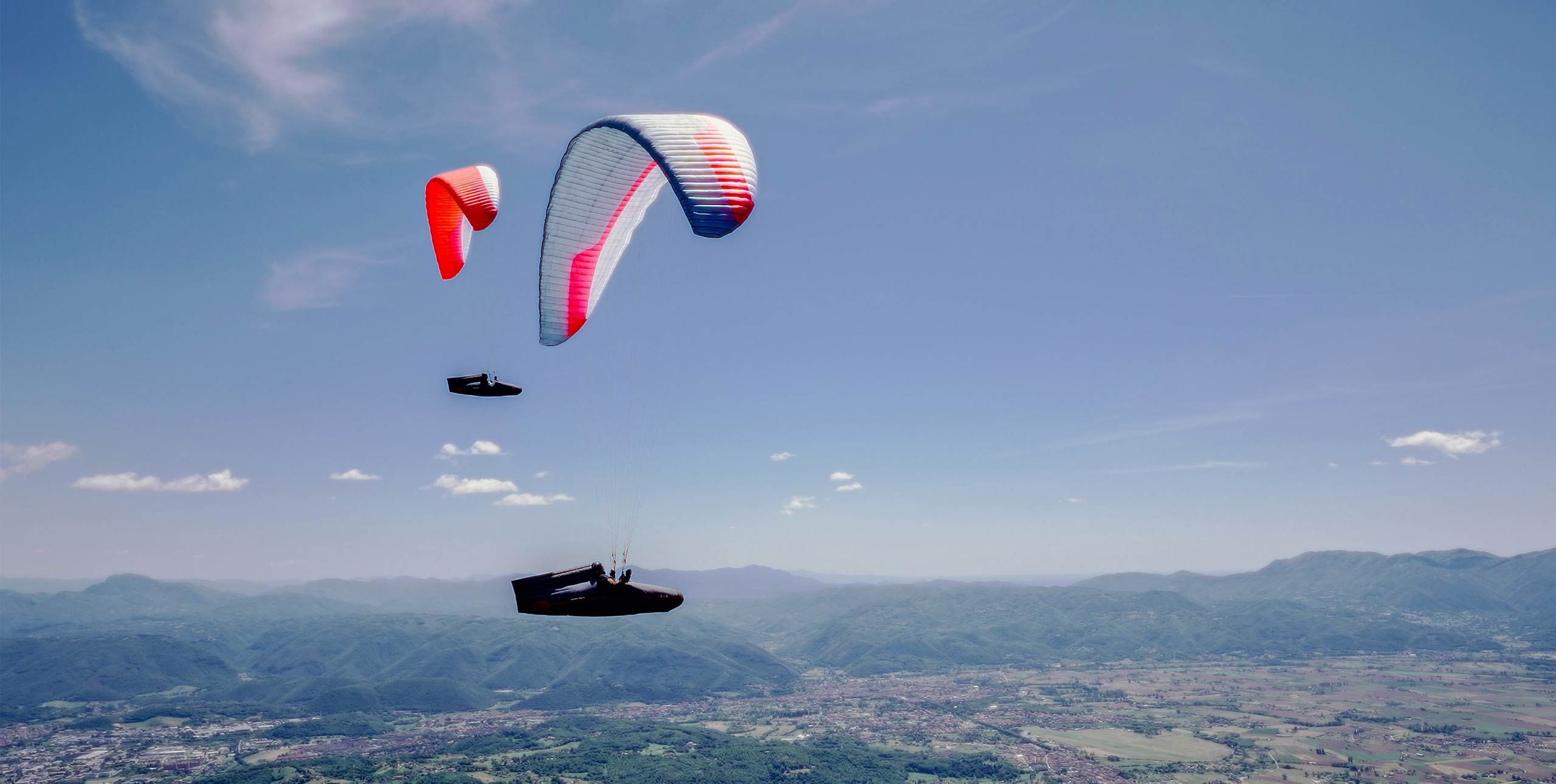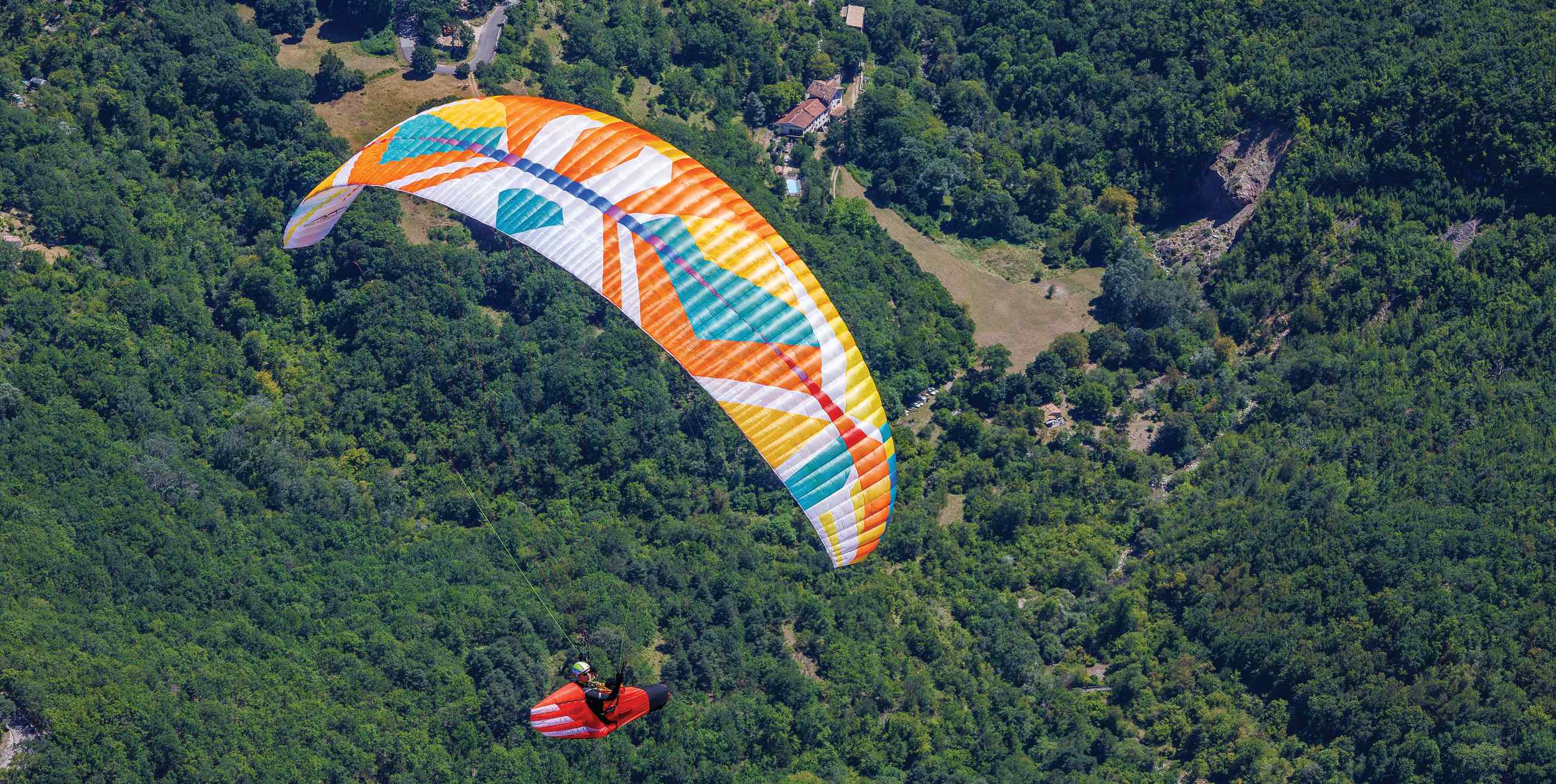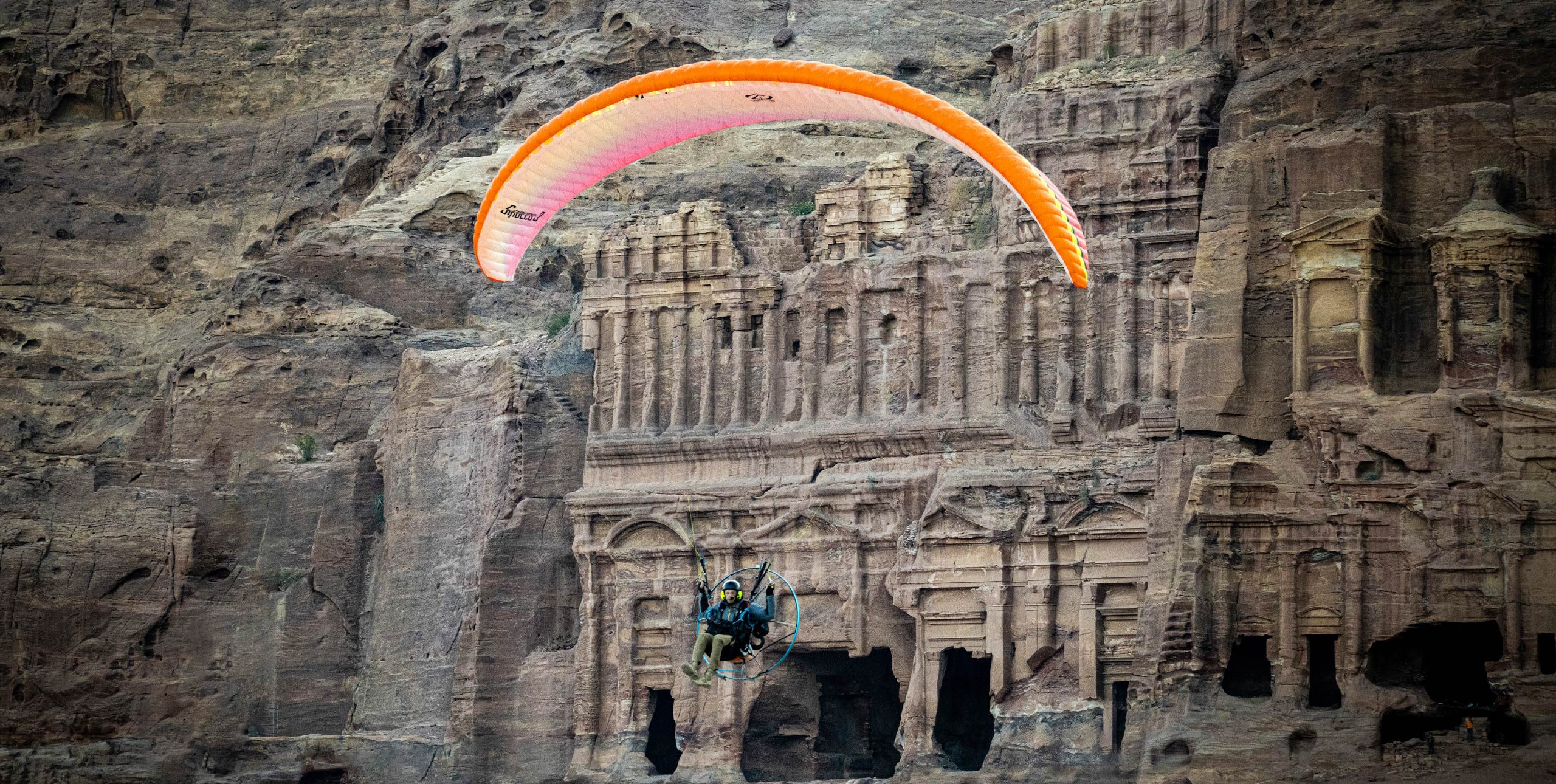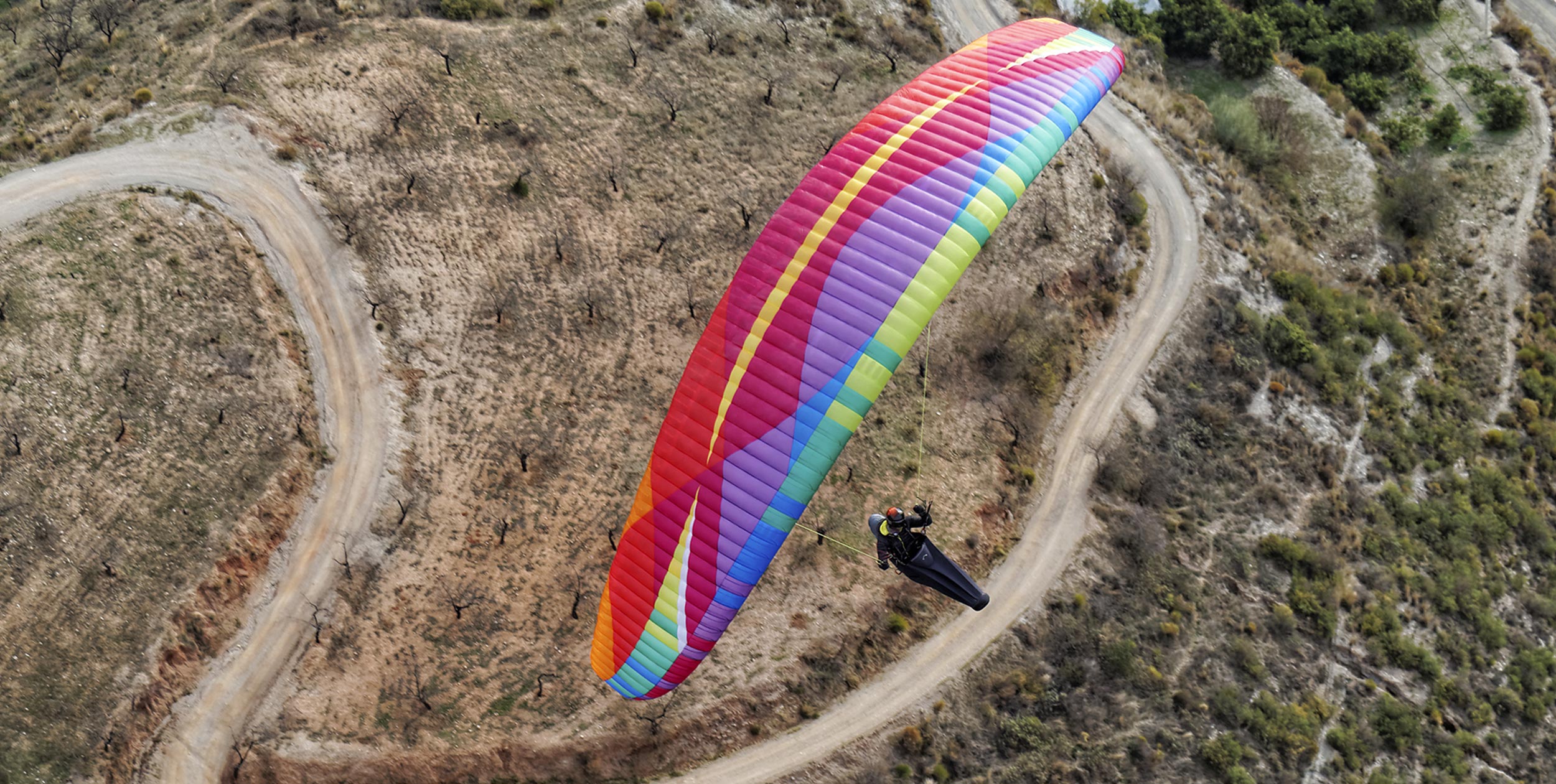
The trademark BGD colours radiate rather boldly while I’m preparing the Cure 2 for my first flight. It seems as if all available shades of cloth are present in the ‘Alkaline’ coloured review glider. More than the in-your-face colours, the sheer number of parts dazzles me. It looks like great skill is needed to sew all these parts together flawlessly.
The manufacturer clearly succeeded, we’re looking at a quality glider with very little wrinkling visible on the inflated canopy. It has Porcher Skytex 27 and 32 g/m² cloth, Edelrid 8000U lines all the way down, narrow 13mm webbing risers, soft padded brake handles with the trademark one-way magnets and colour-coded green and red, just like the riser loops.
A closer look at the leading edge and upper canopy reveals no fewer than three plastic rods per cell. One for the bottom of the sharknose cell openings, the second over the top of the cell openings and a third one running almost full chord down over the top surface. At the trailing edge there are small mini-ribs. All cells except the tips contain these long rods, to diminish the likelihood of cravats.
When asked for the benefits of these rods, Bruce Goldsmith explained that this gives better tension chordwise over the canopy. This in turn means a higher stability at top speed. “Without the rods, we could not have achieved its high top speed.” Still, the glider is not too heavy at 5kg for the M size (75-95kg).

The Cure 2 has no fewer than 74 cells, 14 more than the first Cure. A notable feature is the “double-skin leading edge” – the lower surface of the leading edge is folded over on itself, to produce a double skin. With the internal pressure of the wing this inflates from behind, giving a cleaner, more stable leading edge.
With a flat aspect ratio of 6.4, the glider has a more moderate A/R than its predecessor, but because of a flatter shape, the projected aspect ratio hasn’t changed at 4.8. The projected aspect ratio is the most indicative of handling, says Goldsmith. “The distance between the pilot and the tips of the glider in space is important.
“The further away the tips, the more challenging the handling. Projected aspect ratio tells you how far away the tips are.”
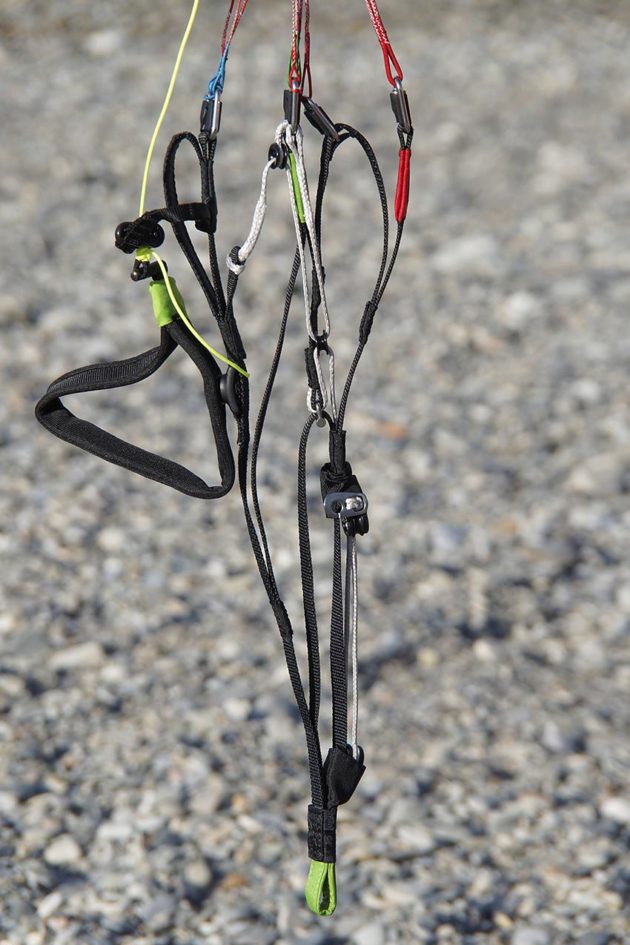
First impressions
The second launch I performed with the Cure 2 was very confidence inspiring (I’ll get to the first one in a bit). We found ourselves on a soaring hill at the end of the day, where the rocky launch area is right in the venturi. The wind was howling well over 30km/h and we watched another very capable pilot being catapulted into the lift band in a less than comfortable way. Luckily, a little stroll down I found a small clearing outside the venturi where I could carefully lay out most of the glider over the bushes. The Cure 2 behaved very well. It inflated smoothly and was easily controlled, so without any drama I was up soaring the hill and having great fun.
The Cure 2 instantly felt very playful and is nicely sensitive to weightshift. Playing around, my wingovers got a bit out of hand, but the Cure 2 also saved me there: no serious consequences, just a bit of pressure loss.
Earlier that day, we were at a south launch with almost imperceptible thermic activity. It was my first launch of the Cure 2 out of the bag, and it felt like perfect conditions: a very light breeze from the house thermal. It took me a couple of tries though, to get the glider well inflated above my head. It felt like the Cure 2 needed quite some time to fill and gain its shape. In the meantime, it is sensitive and moves around or partly collapses.

Most of my other launches were in similar conditions and confirmed this experience, as did several other pilots who flew the Cure 2. In light winds I found it works best to forward launch: give the glider a good first impulse without pulling the As, then wait until it is well shaped and overhead. This should be no issue for pilots flying an EN-C.
In stronger winds the Cure 2 continued to handle nicely and was easily controlled.
The glider has a long brake range for an EN-C glider. Although in flight the control is nice and direct, the range to stall is up to 60cm according to the EN test report. On the one hand, this is a nice safety feature. On the other hand, it is more work while controlling the glider on the ground, especially for shorter people.
Efficiency
The light winter thermals of southern Spain were great for investigating the Cure 2’s character. Efficiency seems to be the keyword here. Because of the agile handling both on weightshift and a little brake input, it can turn efficiently on a dime. It is easy to find the exact bank angle you want for efficient climbing. It relays all the information you need, no more and no less, mainly through the risers. Combined with the efficient weightshift it is easy to control in many conditions and gives a very comfortable flight.
I found the tips frequently lose pressure as a safety feature, the so-called “progressive stability”. This means the glider loses pressure in turbulence progressively, starting with little tip tucks in light turbulence. This helps pilots feel turbulence and act on it to prevent worse, instead of having no indication of turbulence at all, until a large collapse happens. With the Cure 2, this means dives, collapses or worse are rare.
The last flights were in small and punchy leeside thermals. I felt really comfortable on the Cure 2 and was quickly flying on top of the stack. Climbing in a small core is just a lot easier when you can position the glider exactly where you want even through all the leeside bumps.
Top of class speed
Flying together with some other EN-Cs the glider certainly seems quite fast. Flying on bar feels very solid, and I had no trouble whatsoever pushing until the pulleys overlapped and then controlling the glider with the C-handles. The C-steering handle is linked to the B-riser with a 33% ratio, so the B-riser is only pulled by one-third of the C-riser displacement, making the C-riser steering lighter than it would be otherwise. I found the C-riser steering easy to hold and at the right height for my arms.
BGD’s claim of a 60km/h top speed, which entails a more-than-20km/h increase over trim speed on full bar, is nonetheless a bold one and called for an accurate measurement with our Flymaster TAS airspeed measurement probe. Flying the M size at approximately 93kg (2kg under the maximum) with a Woody Valley GTO X-Alps pod harness, we measured a trim speed of 39km/h (+/- 1km/h) and a top speed of 59km/h (+/- 1km/h), confirming BGD’s claim about top speed. This is at the moment the fastest glider in the C-class with a previously unheard of speed increase on bar of 20km/h. It really is fast.

Final words
The Cure 2 is exactly what is says on the box: high performance and speed with low pilot stress. Its DNA is the same as the first Cure, but it is certainly a faster, sportier glider. If you are comfortable in the sports class, you will be comfortable on the Cure 2 and fly far.
HOW WE TEST SPEED
We aim to fly at 3kg below the top of the certified weight range using a pod harness. Flying in calm air, at a consistent heading over a period of at least 20 seconds, we note the trim speed on a Flymaster TAS airspeed probe and GPS.
We then glide at full speed – pulleys overlapping. Once the speed is settled we keep a consistent speed for 15 seconds and note the TAS top speed and GPS top speed. We note the difference between the GPS trim and top speeds to ensure accuracy. We repeat the test three times. Read how we do it in full at:
GLIDER SPECIFICATIONS
BGD say: “High performance and low stress. It’s fast on glide with excellent stability in wind and turbulence. Excellent performance for its class.”
Use: XC flying
Pilot level: frequent flyers, regular XC pilots
Sizes: S, M, ML, L
Certified take-off weight (kg): 65-85, 75-95, 85-107, 98-122
Flat area (m²): 21.5, 23, 24.6, 26.8
Glider weight (kg): 4.8, 5, 5.3, 5.6
Cells: 74
Flat aspect ratio: 6.4
Speed (our test): 39km/h trim, 60km/h top
Certification: EN / LTF C
Erwin Voogt
Erwin has flown paragliders since 2008 and is a paragliding instructor in the Netherlands. He enjoys all aspects of free flying – XC, hike-and-fly, a bit of acro and helping new pilots with their first steps. Erwin flew the BGD Cure 2 (M) at an all-up weight of 88kg. The review was written up by his partner, pilot and science writer Bastienne Wentzel.
Published in Cross Country issue 209 (May 2020)

